The Role of Nitrate on the Sol-Gel Spread Self-Combustion Process and Its Effect on the NH3-SCR Activity of Magnetic Iron-Based Catalyst
Abstract
:1. Introduction
2. Results and Discussion
2.1. NH3–SCR Activity
2.2. Thermo-Gravimetric Analysis (TG-DTG-DSC)
2.3. Structural Properties
2.3.1. X-Ray Diffraction
2.3.2. Scanning Electron Microscopy (SEM)
2.3.3. N2 Adsorption–Desorption
2.3.4. X-ray Photoelectron Spectroscopy (XPS) and H2-Temperature Program Reduction (H2-TPR)
2.3.5. NH3–Temperature Programmed Desorption (NH3-TPD)
2.4. Catalytic Mechanism
3. Experimental
3.1. Synthesis of the Catalyst
3.2. Catalytic Measurement and Characterization
4. Conclusions
Author Contributions
Funding
Acknowledgments
Conflicts of Interest
References
- Parvulescu, V.; Delmon, B.; Grange, P. Catalytic removal of NO. Catal. Today 1998, 46, 233–316. [Google Scholar] [CrossRef]
- Forzatti, P.; Nova, I.; Tronconi, E. Enhanced NH3 selective catalytic reduction for NOx abatement. Angew. Chem. Int. Edit. 2009, 48, 8366–8368. [Google Scholar] [CrossRef] [PubMed]
- Husain, D. Chemistry of atmospheres: An introduction to the chemistry of atmospheres of earth the planets and their satellites by R. P. Wayne. J. Photo. Chem. Photobiol. A Chem. 1992, 63, 253–254. [Google Scholar] [CrossRef]
- Zhao, S.J.; Wang, L.; Wang, Y.; Li, X. Hierarchically porous LaFeO3 perovskite prepared from the pomelo peel bio-template for catalytic oxidation of NO. J. Phys. Chem. Solids 2018, 116, 43–49. [Google Scholar] [CrossRef]
- Amanatidis, S.; Ntziachristos, L.; Giechaskiel, B.; Bergmann, A.; Samaras, Z. Impact of selective catalytic reduction on exhaust particle formation over excess ammonia events. Environ. Sci. Technol. 2014, 48, 11527–11534. [Google Scholar] [CrossRef]
- Gu, Q.; Wang, L.; Wang, Y.; Li, X. Effect of praseodymium substitution on La1-xPrxMnO3 (x=0-0.4) perovskites and catalytic activity for NO oxidation. J. Phys. Chem. Solids 2019, 133, 52–58. [Google Scholar] [CrossRef]
- Ning, P.; Song, Z.X.; Li, H.; Zhang, Q.L.; Liu, X.; Zhang, J.H.; Tang, X.S.; Huang, Z.Z. Selective catalytic reduction of NO with NH3 over CeO2-ZrO2-WO3 catalysts prepared by different methods. Appl. Surf. Sci. 2015, 332, 130–137. [Google Scholar] [CrossRef]
- Shang, D.H.; Zhong, Q.; Cai, W. High performance of NO oxidation over Ce-Co-Ti catalyst: The interaction between Ce and Co. Appl. Surf. Sci. 2015, 325, 211–216. [Google Scholar] [CrossRef]
- Dunn, J.P.; Koppula, P.R.; Stenger, H.G.; Wachs, I.E. Oxidation of sulfur dioxide to sulfur trioxide over supported vanadia catalysts. Appl. Catal. B 1998, 19, 103–117. [Google Scholar] [CrossRef]
- Boningari, T.; Ettireddy, P.R.; Somogyvari, A.; Liu, Y.; Vorontsov, A.; McDonald, C.A.; Smirniotis, P.G. Influence of elevated surface texture hydrated titania on Ce-doped Mn/TiO2 catalysts for the low-temperature SCR of NOx under oxygen-rich conditions. J. Catal. 2015, 325, 145–155. [Google Scholar] [CrossRef]
- Narasimharao, K.; Malik, M.A.; Mokhtar, M.M.; Basahel, S.N.; Al-Thabaiti, S.A. Iron oxide supported sulfated TiO2 nanotube catalysts for NO reduction with propane. Ceram. Int. 2014, 40, 4039–4053. [Google Scholar] [CrossRef]
- Jiang, Y.; Gao, X.; Zhang, Y.X.; Wu, W.H.; Song, H.; Luo, Z.Y.; Cen, K.F. Effects of PbCl2 on selective catalytic reduction of NO with NH3 over vanadia-based catalysts. J. Hazard. Mater. 2014, 274, 270–278. [Google Scholar] [CrossRef] [PubMed]
- Kröcher, O.; Elsener, M. Chemical deactivation of V2O5-WO3/TiO2 SCR catalysts by additives and impurities from fuels, lubrication oils, and urea solution: I. catalytic studies. Appl. Catal. B 2008, 77, 215–227. [Google Scholar] [CrossRef]
- Li, X.D.; Wang, C.; Huang, J.Q.; Yuan, Y.; Wang, B.; Zhang, H.B.; Xia, F.; Xiao, J.Z. The effects of Cu-content on Mg2CuxFe1O3.5+x electrodes for YSZ-based mixed-potential type NH3 sensors. Ceram. Int. 2016, 42, 9363–9370. [Google Scholar] [CrossRef]
- Balle, P.; Geiger, B.; Kureti, S. Selective catalytic reduction of NOx by NH3 on Fe/HBEA zeolite catalysts in oxygen-rich exhaust. Appl. Catal. B 2009, 85, 109–119. [Google Scholar] [CrossRef]
- Duan, L.B.; Duan, Y.; Sarbassov, Y.; Li, Y.; Anthony, E. SO3 formation under oxy-CFB combustion conditions. Int. J. Greenh. Gas Con. 2015, 43, 172–178. [Google Scholar] [CrossRef]
- Zhao, S.J.; Wang, Y.; Wang, L.; Jin, Y.L. Preparation, characterization and catalytic application of hierarchically porous LaFeO3 from a pomelo peel template Inorg. Chem. Front. 2017, 4, 994–1002. [Google Scholar]
- Chen, J.; Duan, L.; Donat, F.; Müller, C.; Anthony, E.; Fan, M. Self-activated nanostructured composite for improved CaL-CLC technology. Chem. Eng. J. 2018, 351, 1038–1046. [Google Scholar] [CrossRef] [Green Version]
- Kazantsev, P.A.R.V.; Pankina, G.V.; Maslakov, K.I.; Lunin, B.S.; Eliseev, O.L. Carbon-Silica composite as an effective support for iron fischer-tropsch synthesis catalysts. Energy Technol. 2019, 7, 1800961. [Google Scholar]
- Chen, J.; Duan, L.; Sun, Z. Accurate control of cage-Like CaO hollow microspheres for enhanced CO2 capture in calcium looping via a template-assisted synthesis approach. Environ. Sci. Technol. 2019, 53, 2249–2259. [Google Scholar] [CrossRef]
- Wu, D.; Shi, Z.F.; Zhang, X.P.; Wu, X.H. Progress of studies on preparation of TiO2 photocatalysts with sol-gel auto igniting synthesis. Earth Environ. Sci. 2017, 94, 1–4. [Google Scholar] [CrossRef] [Green Version]
- Parida, K.M.; Reddy, K.H.; Martha, S.; Das, N.; Bisawal, N. Fabrication of nanocrystalline LaFeO3: An efficient sol–gel auto-combustion assisted visible light responsive photocatalyst for water decomposition. Int. J. Hydrogen Energy 2010, 35, 12161–12168. [Google Scholar] [CrossRef]
- Sijo, A.K. Magnetic and structural properties of CoCrxFe2−xO4 spinels prepared by solution self-combustion method. Ceram. Int. 2017, 43, 2288–2290. [Google Scholar] [CrossRef]
- Cannas, C.; Musinu, A.; Peddis, D.; Piccaluga, G. New synthesis of ferrite-silica nanocomposites by a sol-gel auto-combustion. J. Nanopart. Res. 2004, 6, 223–232. [Google Scholar] [CrossRef]
- Kaitlyn, A.; George, K.S. Synthesis of GAGG: Ce3+ powder for ceramics using mechanochemical and solution combustion methods. J. Am. Ceram. Soc. 2018, 101, 3837–3849. [Google Scholar]
- Yeh, C.L.; Ke, C.Y. Synthesis of TiB2-Al2O3-FeAl composites via self-sustaining combustion with Fe2O3/TiO2-based thermite mixtures. Ceram. Int. 2018, 44, 16030–16034. [Google Scholar] [CrossRef]
- Xiong, Z.B.; Ning, X.; Zhou, F.; Yang, B.; Tu, Y.W.; Jin, J.; Lu, W.; Liu, Z.H. Environment-friendly magnetic Fe-Ce-W catalyst for the selective catalytic reduction of NOx with NH3: Influence of citric acid content on its activity-structure relationship. RSC Adv. 2018, 8, 21915–21925. [Google Scholar] [CrossRef] [Green Version]
- Ianoş, R.; Tăculescu, A.; Păcurariu, C.; Lazău, I. Solution combustion synthesis and characterization of magnetite, Fe3O4, nanopowders. J. Am. Ceram. Soc. 2012, 95, 2236–2240. [Google Scholar] [CrossRef]
- Ianoş, R.; Moacă, E.A.; Căpraru, A.; Lazău, R.; Păcurariu, C. Maghemite, γ-Fe2O3, nanoparticles preparation via carbon-templated solution combustion synthesis. Ceram. Int. 2018, 44, 14090–14094. [Google Scholar] [CrossRef]
- Zhao, J.; Liang, Y.; Yan, H.; Gu, A.; He, S.; Liu, J. Preparation of nano-MnZn ferrite by gel-self-combustion technique. J. Mater. Sci. Eng. 2003, 21, 68–71. [Google Scholar]
- Xu, L.T.; Niu, S.L.; Lu, C.M.; Zhang, Q. Influence of calcination temperature on Fe0.8Mg0.2Oz catalyst for selective catalytic reduction of NOx with NH3. Fuel 2018, 219, 248–258. [Google Scholar] [CrossRef]
- Zhao, K.; Meng, J.P.; Lu, J.Y.; He, Y.; Huang, H.Z.; Tang, Z.C.; Zhen, X.P. Sol-gel one-pot synthesis of efficient and environmentally friendly iron-based catalysts for NH3-SCR. Appl. Surf. Sci. 2018, 445, 454–461. [Google Scholar] [CrossRef]
- Zhang, Q.L.; Liu, X.; Ning, P.; Song, Z.X. Enhanced performance in NOx reduction by NH3 over a mesoporous Ce-Ti-MoOx catalyst stabilized by a carbon template. Catal. Sci. Technol. 2015, 5, 2260–2269. [Google Scholar] [CrossRef]
- Liu, F.D.; He, H. Structure-activity relationship of iron titanate catalysts in the selective catalytic reduction of NOx with NH3. J. Phys. Chem. C 2010, 114, 16929–16936. [Google Scholar] [CrossRef]
- Wang, R.N.; Wu, X.; Zou, C.L.; Li, X.J.; Du, Y.L. NOx removal by selective catalytic reduction with ammonia over a hydrotalcite-derived NiFe mixed oxide. Catalysts 2018, 8, 384. [Google Scholar] [CrossRef] [Green Version]
- Tan, J.B.; Wei, Y.C.; Sun, Y.Q.; Liu, J.; Zhao, Z.; Song, W.Y.; Li, J.M.; Zhang, X. Simultaneous removal of NOx and soot particulates from diesel engine exhaust by 3DOM Fe-Mn oxide catalysts. J. Ind. Eng. Chem. 2018, 63, 84–94. [Google Scholar] [CrossRef]
- Wang, H.; Ning, P.; Zhang, Q.; Liu, X.; Zhang, T.; Fan, J.; Wang, J.; Long, K. Promotional mechanism of WO3 over RuO2-Fe2O3 catalyst for NH3-SCO reaction. Appl. Catal. A 2018, 561, 158–167. [Google Scholar] [CrossRef]
- Wang, H.; Qu, Z.P.; Xie, H.B.; Maeda, N.; Lei, M.; Wang, Z. Insight into the mesoporous FexCe1−xO2-δ catalysts for selective catalytic reduction of NO with NH3: Regulable structure and activity. J. Catal. 2016, 338, 56–67. [Google Scholar] [CrossRef]
- Abolfazl, B.R.; Rezaei, M. Low temperature CO oxidation over Fe-Co mixed oxide nanocatalysts. Chem. Eng. J. 2012, 184, 141–146. [Google Scholar]
- Li, X.S.; Li, K.; Yue, Z.P.; Li, X.Y.N.; Zhang, D.; Wang, J.J.; Chen, J.; Li, H. Interaction of phosphorus with a FeTiOx catalyst for selective catalytic reduction of NOx with NH3: Influence on surface acidity and SCR mechanism. Chem. Eng. J. 2018, 347, 173–183. [Google Scholar] [CrossRef]
- Xiong, Z.B.; Liu, J.; Zhou, F.; Liu, D.Y.; Lu, W.; Jin, J.; Ding, S.F. Selective catalytic reduction of NOx with NH3 over iron-cerium-tungsten mixed oxide catalyst prepared by different methods. Appl. Surf. Sci. 2017, 406, 218–225. [Google Scholar] [CrossRef] [Green Version]
- Xiong, Z.B.; Bai, P.; Zhou, F.; Wu, C.; Lu, W.; Jin, J.; Ding, S.F. Magnetic iron-cerium-tungsten mixed oxide pellets prepared through critic acid sol-gel process assisted by microwave irradiation for selective catalytic reduction of NOx with NH3. Powder Technol. 2017, 319, 19–25. [Google Scholar] [CrossRef]
- Li, X.; Li, J.H.; Yue, P.; Xu, B. Selective catalytic reduction of NO with NH3 over novel iron-tungsten mixed oxide catalyst in a broad temperature range. Catal. Sci. Technol. 2015, 5, 4556–4564. [Google Scholar] [CrossRef]
- Zhang, G.; Ren, J.J.; Liu, B.L.; Tian, M.; Zhou, H.W.; Zhao, J.S. In situ hydrothermal preparation and photocatalytic desulfurization performance of metallophthalocyanine sensitized SnO2. J. Inorg. Chim. Acta 2018, 471, 782–787. [Google Scholar] [CrossRef]
- Liu, Y.; Gu, T.T.; Weng, X.L.; Wang, Y. DRIFT studies on the selectivity promotion mechanism of Ca-modified Ce-Mn/TiO2 catalysts for low-temperature NO reduction with NH3. J. Phys. Chem. A 2012, 116, 16582–16592. [Google Scholar] [CrossRef]
- Chen, P.; Tao, L.; Zhu, J.; Zhao, G.; Liu, Y.; Lu, Y. Morphology-controllable hexagonal-phase indium oxide in situ structured onto a thin-felt Al2O3/Al-fiber for the hydrogenation of CO2 to methanol. Energy Technol. 2019, 7, 1800747. [Google Scholar] [CrossRef]
- Liu, J.; Xiong, Z.B.; Zhou, F.; Lu, W.; Jin, J.; Ding, S.F. Promotional effect of H2O2 modification on the cerium-tungsten-titanium mixed oxide catalyst for selective catalytic reduction of NO with NH3. J. Phys. Chem. Solids 2018, 121, 360–366. [Google Scholar] [CrossRef]
- Castellanos, I.; Marie, O. An operando FT-IR study of the NOx SCR over Co-HFER and Fe-HFER using acetylene as a reducing agent. Catal. Today 2017, 283, 54–65. [Google Scholar] [CrossRef]
- Shi, J.; Zhang, Y.; Zhang, Z.H.; Fan, Z.Y.; Chen, M.X.; Zhang, Z.X.; Shangguan, W.F. Water promotion mechanism on the NH3-SCR over Fe-BEA catalyst. Catal. Commun. 2018, 115, 59–63. [Google Scholar] [CrossRef]
- Devadas, M.; KroCher, O.; Elsener, M.; Wokaun, A.; Mitrikas, G.; Sӧger, N.; Pfeifer, M.; Demel, Y.; Mussmann, L. Characterization and catalytic investigation of Fe-ZSM5 for urea-SCR. Catal. Today 2007, 119, 137–144. [Google Scholar] [CrossRef]
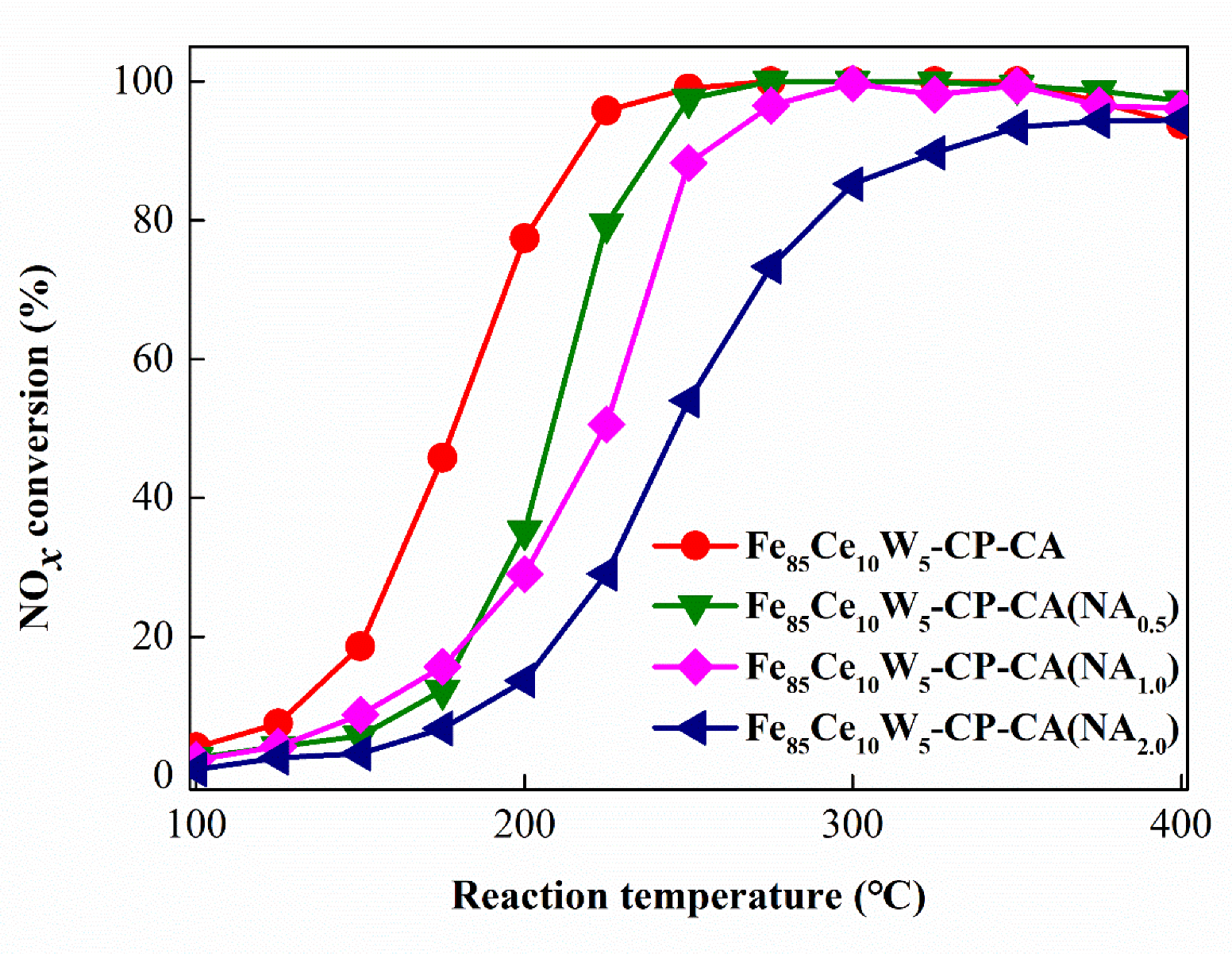
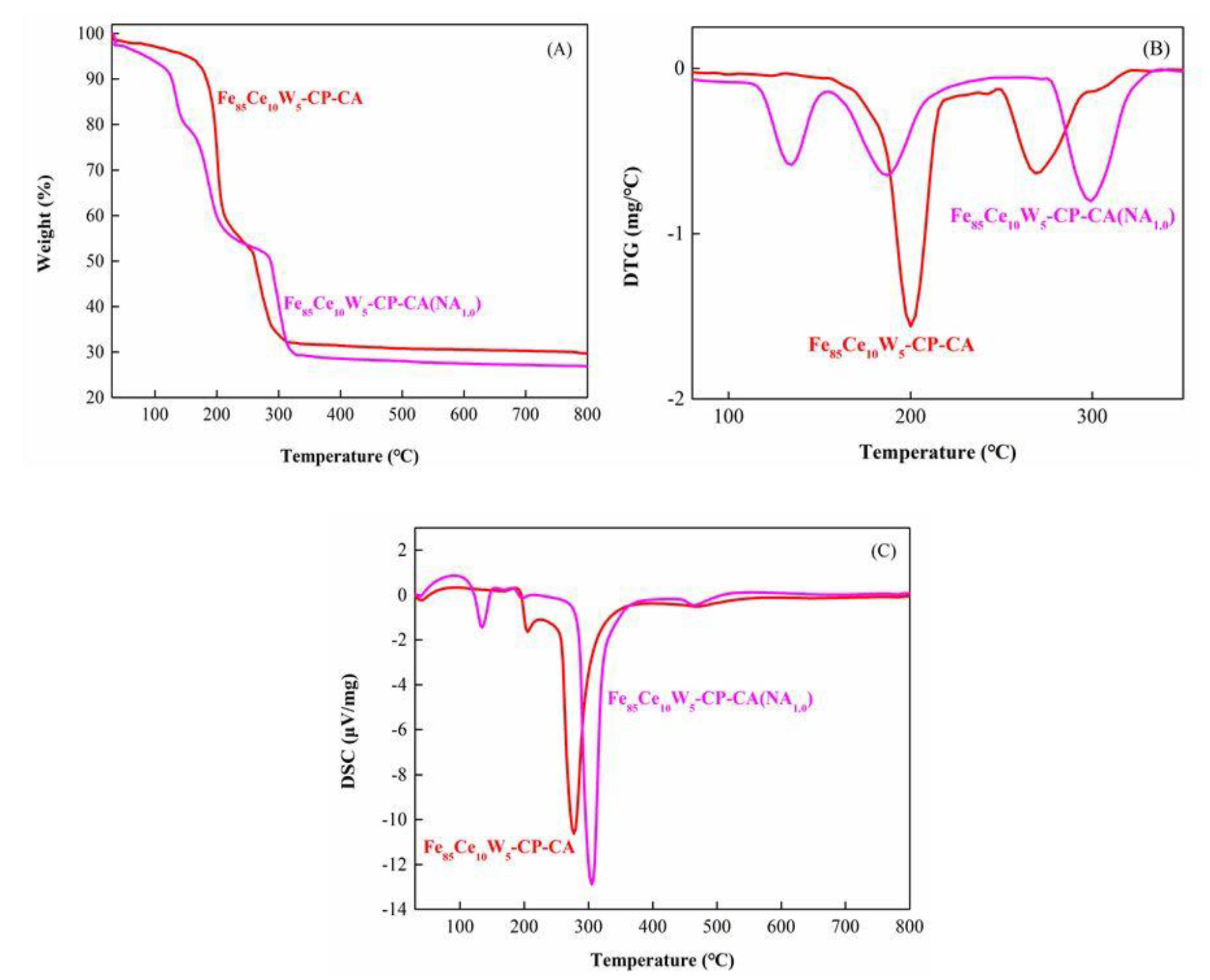



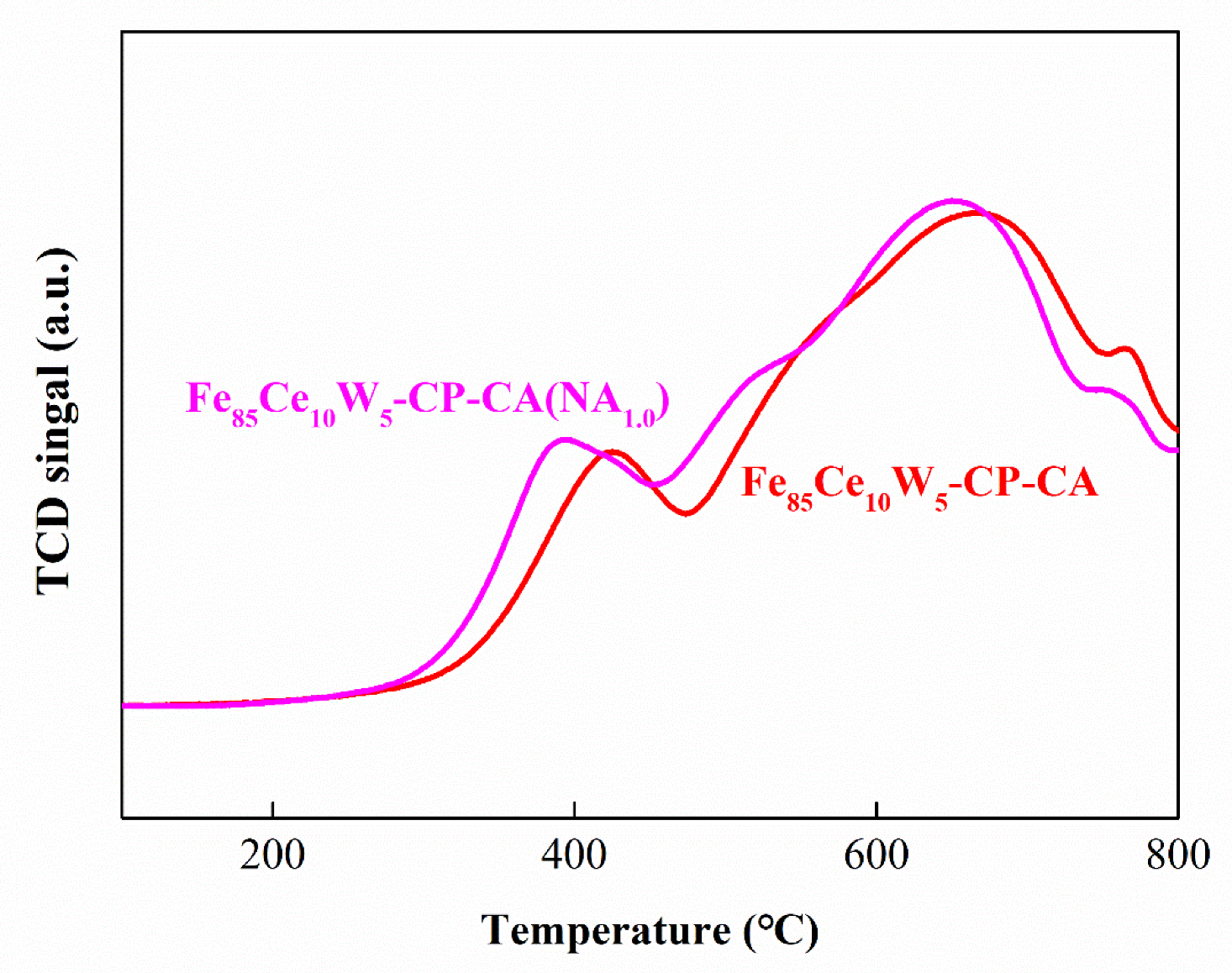
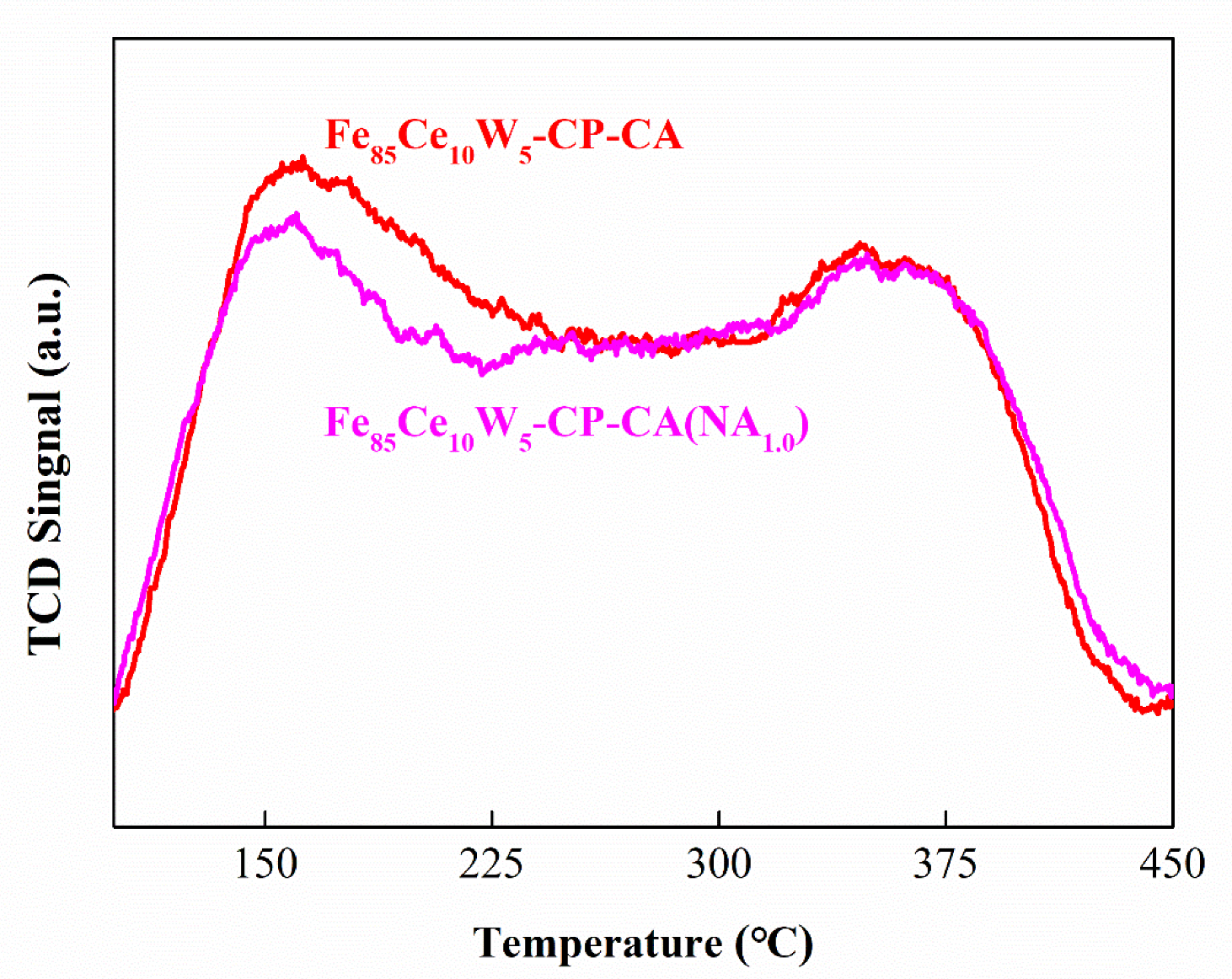
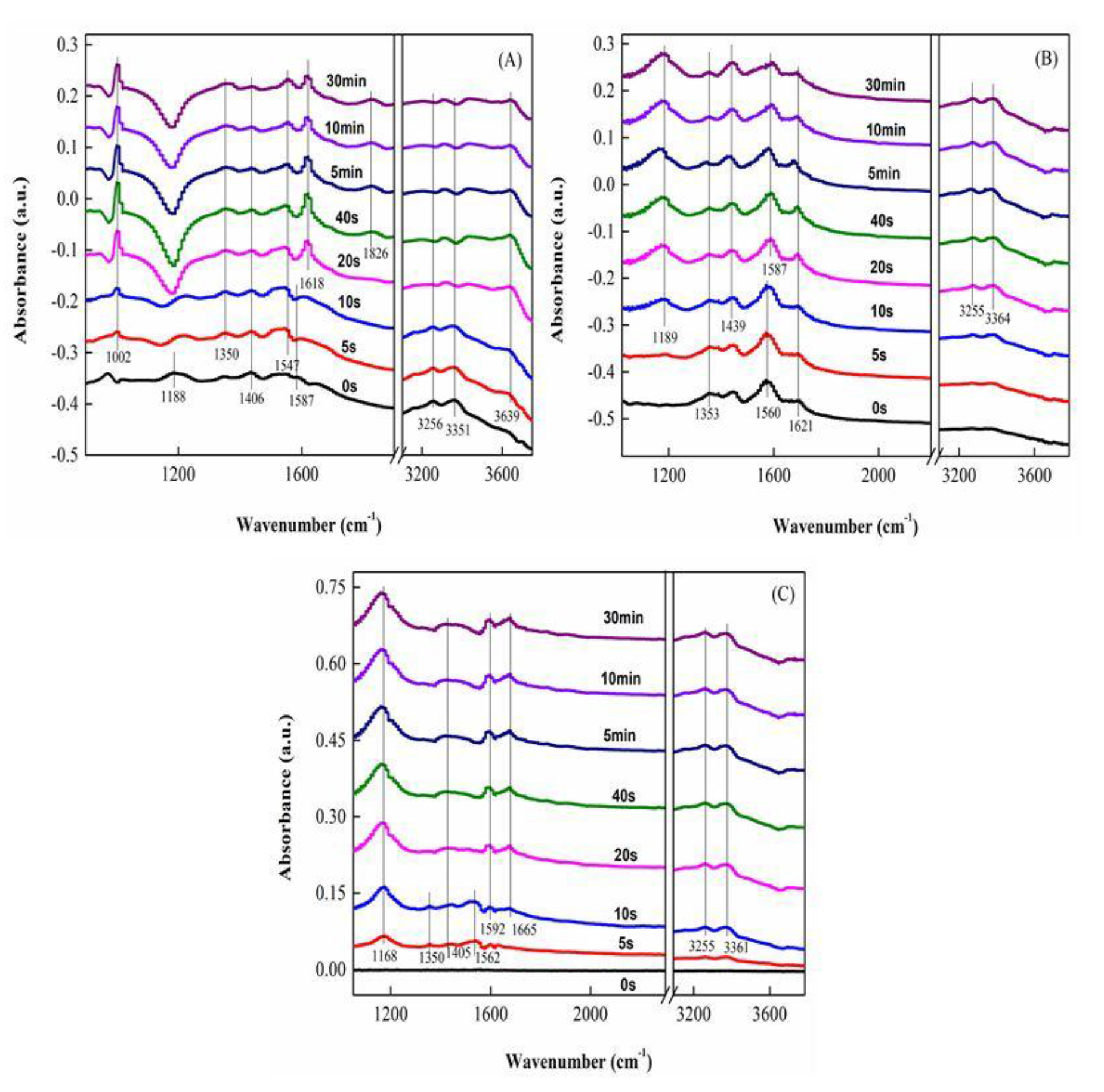
| Samples | NOx Conversion (mg/(g·h)) | |||
|---|---|---|---|---|
| 125 °C | 150 °C | 175 °C | 200 °C | |
| Fe85Ce10W5–CP–CA | 8.5 | 21.0 | 51.6 | 87.3 |
| Fe85Ce10W5–CP–CA(NA1.0) | 7.4 | 15.4 | 27.2 | 50.4 |
| Samples | SBET a (m2/g) | Pore Volume b (cm3/g) | Pore Diameter c (nm) | D d (nm) |
|---|---|---|---|---|
| Fe85Ce10W5–CP–CA | 90.850 | 0.178 | 6.170 | 13.000 |
| Fe85Ce10W5–CP–CA(NA1.0) | 93.130 | 0.146 | 4.920 | 14.400 |
| Samples | Surface Atomic Concentrations (%) | |||||||
|---|---|---|---|---|---|---|---|---|
| Fe2+ | Fe3+ | Fetotal | Ce | W | Oα | Oβ | Ototal | |
| Fe85Ce10W5-CP-CA | 5.65 | 11.71 | 17.36 | 7.24 | 2.89 | 15.82 | 56.69 | 72.51 |
| Fe85Ce10W5-CP-CA(NA1.0) | 5.73 | 11.83 | 17.56 | 6.33 | 2.36 | 16.09 | 57.66 | 73.75 |
© 2020 by the authors. Licensee MDPI, Basel, Switzerland. This article is an open access article distributed under the terms and conditions of the Creative Commons Attribution (CC BY) license (http://creativecommons.org/licenses/by/4.0/).
Share and Cite
Ning, X.; Xiong, Z.-b.; Yang, B.; Lu, W.; Wu, S.-m. The Role of Nitrate on the Sol-Gel Spread Self-Combustion Process and Its Effect on the NH3-SCR Activity of Magnetic Iron-Based Catalyst. Catalysts 2020, 10, 314. https://doi.org/10.3390/catal10030314
Ning X, Xiong Z-b, Yang B, Lu W, Wu S-m. The Role of Nitrate on the Sol-Gel Spread Self-Combustion Process and Its Effect on the NH3-SCR Activity of Magnetic Iron-Based Catalyst. Catalysts. 2020; 10(3):314. https://doi.org/10.3390/catal10030314
Chicago/Turabian StyleNing, Xing, Zhi-bo Xiong, Bin Yang, Wei Lu, and Shui-mu Wu. 2020. "The Role of Nitrate on the Sol-Gel Spread Self-Combustion Process and Its Effect on the NH3-SCR Activity of Magnetic Iron-Based Catalyst" Catalysts 10, no. 3: 314. https://doi.org/10.3390/catal10030314
APA StyleNing, X., Xiong, Z.-b., Yang, B., Lu, W., & Wu, S.-m. (2020). The Role of Nitrate on the Sol-Gel Spread Self-Combustion Process and Its Effect on the NH3-SCR Activity of Magnetic Iron-Based Catalyst. Catalysts, 10(3), 314. https://doi.org/10.3390/catal10030314




